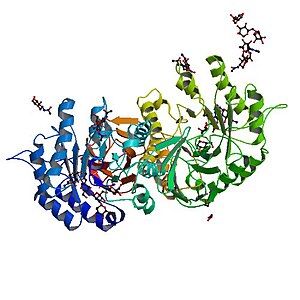Fabry disease – an overview
Fabry disease, also known as Anderson–Fabry disease and GLA deficiency, is a rare genetic disease that can affect many parts of the body, including the kidneys, heart, brain, and skin. Fabry disease is one of a group of conditions known as lysosomal storage diseases. Fabry disease affects approximately 1 in 1,000-9,000 people.
1. Genetic basis
Fabry disease is caused by mutations in the GLA gene, which provides instructions for making an enzyme called alpha-galactosidase A. This enzyme is essential for breaking down a fatty substance called globotriaosylceramide (Gb3).

Alpha galactosidase – the deficient protein in Fabry disease.
2. Inheritance – X-Linked
Fabry disease is inherited in an X-linked manner, meaning the gene associated with the disorder is located on the X chromosome. As a result, it primarily affects males, whilst females can be carriers.
3. Cause – enzyme deficiency
The mutations in the GLA gene lead to a deficiency of the alpha-galactosidase A enzyme. This leads to a reduced ability to break down lipids (fats) into smaller components that provide energy to the body. This deficiency results in the accumulation of Gb3 in various cells and tissues throughout the body.
4. Onset and progression
Symptoms of Fabry’s disease often appear in childhood or adolescence and progressively worsen over time. However, the age of onset and the severity of symptoms can vary widely among affected individuals.
5. Symptoms
Neurological symptoms include:
- Burning pain in the arms and legs, which worsens in hot weather or following exercise
- Corneal opacities – the buildup of excess material in the clear layers of the cornea (resulting in clouding but no change in vision)
- Hearing loss
- Stroke or heart attack due to fatty storage in blood vessel walls
Other symptoms include:
- Heart enlargement
- Progressive chronic kidney disease, leading to kidney failure (Stage 5 CKD)
- Gastrointestinal difficulties
- Decreased sweating
- Fever
- Angiokeratomas (small, non-cancerous, reddish-purple elevated spots on the skin) may develop on the lower part of the trunk of the body and become more numerous with age.
6. Organ involvement
The accumulation of Gb3 in organs and tissues can lead to complications such as chronic kidney disease, heart disease, and neurological issues. The severity and specific organs affected can differ among individuals.
7. Diagnosis
Diagnosing Fabry disease involves medical assessment, genetic testing, and measuring alpha-galactosidase A enzyme levels. Early diagnosis is essential for treatment to start as soon as possible.
8. Treatment
While there is no cure for Fabry disease, various treatments aim to alleviate symptoms and slow the progression of the disorder. Enzyme replacement therapy (ERT) is a common approach that involves intravenous infusion of a synthetic form of the missing enzyme. Enzyme replacement can reduce pain, and preserve organ function in some people with Fabry disease.
9. Life expectancy
With advancements in treatment, the life expectancy of people with Fabry disease has improved. However, the disorder can still lead to significant health problems, and outcomes vary depending on the severity of symptoms and complications.
10. Supportive care
In addition to specific treatments, people with Fabry disease may benefit from supportive care such as pain management, physiotherapy, and regular monitoring of organ function; to address specific symptoms and improve overall quality of life.
Summary
We have described Fabry disease – an overview. We hope it has been helpful.
Other resources
Here is more information on Fabry disease, and on the UKKA website.
Last Reviewed on 25 November 2023
